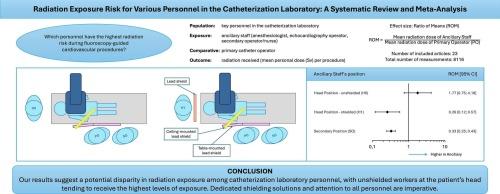导管实验室不同人员的辐射暴露风险:一项系统回顾和荟萃分析
IF 2.7
3区 医学
Q1 RADIOLOGY, NUCLEAR MEDICINE & MEDICAL IMAGING
Physica Medica-European Journal of Medical Physics
Pub Date : 2025-08-26
DOI:10.1016/j.ejmp.2025.105096
引用次数: 0
摘要
目的:辐射暴露是导管实验室工作人员公认的职业危害。然而,不同工作人员角色之间的接触差异程度仍不清楚。现有的研究主要集中在主要操作人员身上,在了解辅助人员的辐射风险方面存在空白。本研究旨在评估工作人员的位置和遮挡对辐射暴露的影响,重点关注透视引导下心血管手术中主要操作人员和辅助工作人员之间的差异。方法在2023年11月20日对5个数据库进行系统检索后,我们纳入了报告冠状动脉造影、结构性心脏介入、电生理手术或血管内主动脉介入的辐射数据的研究,至少有一名辅助工作人员在预定位置。在荟萃分析中,使用均值比(ROM)比较相对于主要操作者的辐射暴露。使用rob2或ROBINS-E评估偏倚风险。审查方案注册号为CRD42023484491。我们的荟萃分析基于23项研究中3091次手术的8116次测量结果,表明没有屏蔽的患者头部工作人员可能比主要操作人员经历更高的辐射暴露(ROM 1.77, 95% CI: 0.75-4.18),尽管这种差异没有达到统计学意义。头部或二级/助理位置的防护工人比主要操作人员接受的辐射明显更低(ROM 0.26, 95% CI: 0.12-0.57; ROM 0.33, 95% CI: 0.25-0.43)。结论导管实验室工作人员的辐射暴露存在潜在差异,患者头部未遮挡的工作人员的辐射暴露水平最高。专门的屏蔽解决方案和对所有人员的关注是必不可少的。本文章由计算机程序翻译,如有差异,请以英文原文为准。

Radiation exposure risk for various personnel in the catheterization laboratory: A systematic review and meta-analysis
Purpose
Radiation exposure is a well-recognized occupational hazard for catheterization lab personnel. However, the extent of exposure disparities among different staff roles remains unclear. Existing research primarily focuses on primary operators, leaving a gap in understanding radiation risks for ancillary staff. This study aims to evaluate how staff positioning and shielding affect radiation exposure, focusing on disparities between primary operators and ancillary staff during fluoroscopy-guided cardiovascular procedures.
Method
After a systematic search across five databases on November 20, 2023, we included studies reporting radiation data for coronary angiographies, structural heart interventions, electrophysiological procedures, or endovascular aorta interventions, with at least one ancillary staff member in prespecified positions. Radiation exposures were compared relative to the primary operator using the Ratio of Means (ROM) during meta-analysis. Risk of Bias was assessed using RoB-2 or ROBINS-E. The review protocol was registered as CRD42023484491.
Results
Our meta-analysis, based on 8116 measurements from 3091 procedures across 23 studies, suggests that personnel at the patient’s head without shielding may experience higher radiation exposure than primary operators (ROM 1.77, 95% CI: 0.75–4.18), although this difference didn’t reach statistical significance. Shielded workers at the head or in secondary/assistant positions received significantly lower radiation than primary operators (ROM 0.26, 95% CI: 0.12–0.57; ROM 0.33, 95% CI: 0.25–0.43).
Conclusions
Our results suggest a potential disparity in radiation exposure among catheterization laboratory personnel, with unshielded workers at the patient’s head tending to receive the highest levels of exposure.
Dedicated shielding solutions and attention to all personnel are imperative.
求助全文
通过发布文献求助,成功后即可免费获取论文全文。
去求助
来源期刊
CiteScore
6.80
自引率
14.70%
发文量
493
审稿时长
78 days
期刊介绍:
Physica Medica, European Journal of Medical Physics, publishing with Elsevier from 2007, provides an international forum for research and reviews on the following main topics:
Medical Imaging
Radiation Therapy
Radiation Protection
Measuring Systems and Signal Processing
Education and training in Medical Physics
Professional issues in Medical Physics.

 求助内容:
求助内容: 应助结果提醒方式:
应助结果提醒方式:


